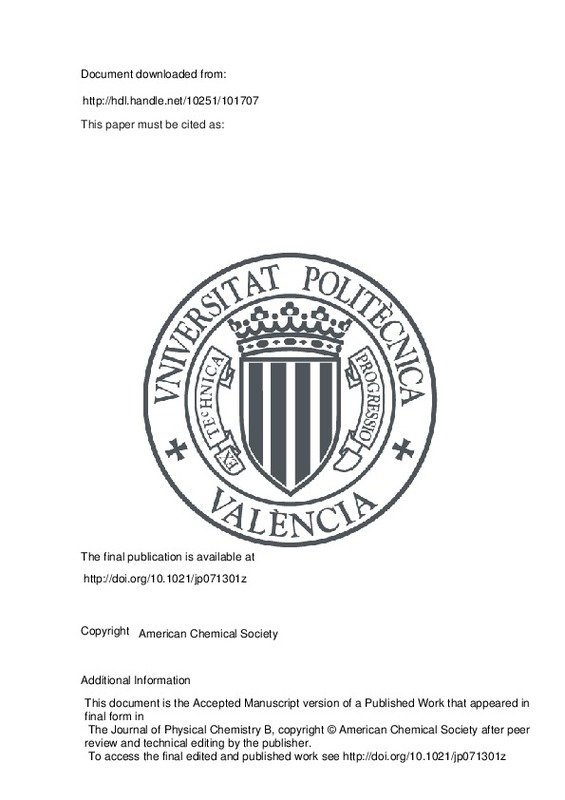JavaScript is disabled for your browser. Some features of this site may not work without it.
Buscar en RiuNet
Listar
Mi cuenta
Estadísticas
Ayuda RiuNet
Admin. UPV
Excited State Interactions in Flurbiprofen-Tryptophan dyads
Mostrar el registro sencillo del ítem
Ficheros en el ítem
| dc.contributor.author | Vayá Pérez, Ignacio
|
es_ES |
| dc.contributor.author | Jiménez Molero, María Consuelo
|
es_ES |
| dc.contributor.author | Miranda Alonso, Miguel Ángel
|
es_ES |
| dc.date.accessioned | 2018-05-11T04:16:37Z | |
| dc.date.available | 2018-05-11T04:16:37Z | |
| dc.date.issued | 2007 | es_ES |
| dc.identifier.issn | 1520-6106 | es_ES |
| dc.identifier.uri | http://hdl.handle.net/10251/101707 | |
| dc.description | This document is the Accepted Manuscript version of a Published Work that appeared in final form in The Journal of Physical Chemistry B, copyright © American Chemical Society after peer review and technical editing by the publisher. To access the final edited and published work see http://doi.org/10.1021/jp071301z | |
| dc.description.abstract | [EN] Fluorescence and laser-flash photolysis measurements have been performed on two pairs of diastereomeric dyads that contain the nonsteroidal anti-inflammatory drug (S)- or (R)-flurbiprofen (FBP) and (S)-tryptophan (Trp), which is a relevant amino acid present in site I of human serum albumin. The fluorescence spectra were obtained when subjected to excitation at 266 nm, where similar to 60% of the light is absorbed by FBP and similar to 40% is absorbed by Trp; the most remarkable feature observed in all dyads was a dramatic fluorescence quenching, and the residual emission was assigned to the Trp chromophore. In addition, an exciplex emission was observed as a broad band between 380 and 500 nm, especially in the case of the (R,S) diastereomers. The fluorescence lifetimes (tau(F)) at lambda(em) = 340 nm were clearly shorter in the dyads than in Trp-derived model compounds; in contrast, the values of tau(F) at lambda(em) = 440 nm (exciplex) were much longer. On the other hand, the typical FBP triplet-triplet transient absorption spectrum was obtained when subjected to laser-flash photolysis, although the signals were less intense than when FBP was directly excited under the same conditions. The main photophysical events in FBP-Trp dyads can be summarized as follows: (1) most of the energy provided by the incident radiation at 266 nm reaches the excited singlet state of Trp ((1)Trp*), either via direct absorption by this chromophore or by singlet singlet energy transfer from excited FBP ((FBP)-F-1*); (2) a minor, yet stereoselective deactivation of (FBP)-F-1* leads to detectable exciplexes and/or radical ion pairs; (3) the main process observed is intramolecular (1)Trp* quenching; and (4) the first triplet excited-state of FBP can be populated by triplet-triplet energy transfer from excited Trp or by back-electron transfer within the charge-separated states. | es_ES |
| dc.description.sponsorship | Financial support from the MCYT (CTQ2004-03811) and the Generalitat Valenciana (GV06/099) is gratefully acknowledged. Author I.V. thanks MEC for a fellowship. | |
| dc.language | Inglés | es_ES |
| dc.publisher | American Chemical Society | es_ES |
| dc.relation.ispartof | The Journal of Physical Chemistry B | es_ES |
| dc.rights | Reserva de todos los derechos | es_ES |
| dc.subject.classification | QUIMICA ANALITICA | es_ES |
| dc.subject.classification | QUIMICA ORGANICA | es_ES |
| dc.title | Excited State Interactions in Flurbiprofen-Tryptophan dyads | es_ES |
| dc.type | Artículo | es_ES |
| dc.identifier.doi | 10.1021/jp071301z | es_ES |
| dc.relation.projectID | info:eu-repo/grantAgreement/MEC//CTQ2004-03811/ES/INTERACCIONES FARMACO-BIOMOLECULA EN LOS ESTADOS EXCITADOS/ | es_ES |
| dc.relation.projectID | info:eu-repo/grantAgreement/GVA//GV06%2F099/ | es_ES |
| dc.rights.accessRights | Abierto | es_ES |
| dc.contributor.affiliation | Universitat Politècnica de València. Departamento de Química - Departament de Química | es_ES |
| dc.description.bibliographicCitation | Vayá Pérez, I.; Jiménez Molero, MC.; Miranda Alonso, MÁ. (2007). Excited State Interactions in Flurbiprofen-Tryptophan dyads. The Journal of Physical Chemistry B. 111(31):9363-9371. https://doi.org/10.1021/jp071301z | es_ES |
| dc.description.accrualMethod | S | es_ES |
| dc.relation.publisherversion | http://doi.org/10.1021/jp071301z | es_ES |
| dc.description.upvformatpinicio | 9363 | es_ES |
| dc.description.upvformatpfin | 9371 | es_ES |
| dc.type.version | info:eu-repo/semantics/publishedVersion | es_ES |
| dc.description.volume | 111 | es_ES |
| dc.description.issue | 31 | es_ES |
| dc.identifier.pmid | 17608516 | |
| dc.relation.pasarela | S\31637 | es_ES |
| dc.contributor.funder | Generalitat Valenciana | es_ES |
| dc.contributor.funder | Ministerio de Educación y Ciencia | es_ES |







![[Cerrado]](/themes/UPV/images/candado.png)

